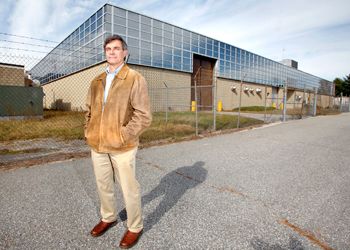Clean tech corridor to launch
 Photo/Tim Greenway
Tom Brubaker leads the Midcoast Regional Redevelopment Authority’s efforts to attract clean tech businesses to the former Brunswick Naval Air Station
Photo/Tim Greenway
Tom Brubaker leads the Midcoast Regional Redevelopment Authority’s efforts to attract clean tech businesses to the former Brunswick Naval Air Station
It’s a good day to tour a ghost town. The gray sky over Brunswick Landing has alternated for hours between drizzle and outright downpour, and what sunlight filters through blanches this maze of empty buildings different shades of gray. Tom Brubaker drives slowly past P3 planes parked in the grass, past a glistening empty airstrip and the shuttered hangars fronting it. He stops his car in a parking lot in front of a rain-drenched gazebo and a sprawling, two-story hotel. Tufts of grass sprout up from the cracks in the pavement all around. This is the second largest hotel in the state, Brubaker explains. It, like most of the property here, is move-in ready. Sometimes to an eerie degree. Brubaker says some of these buildings were left with coffee cups on desks, chairs still pulled up to conference tables.
“It’s like the aliens came and sucked all the people away,” he says. Of the 1.8 million square feet of space on the former Brunswick Naval Air Station, which is now operated by the Midcoast Regional Redevelopment Authority, barely one-sixth has been leased since the Navy decommissioned it in June.
But where there’s real estate, there’s potential. Brubaker stops in front of Building 250, a gray metal block with a neat grid of windows enveloping the top floor. This is one of the places Brubaker, MRRA’s clean technology manager, hopes the future can get a toe-hold on campus. Brubaker explains that Building 250 is a perfect incubator for small to medium-sized clean technology companies, the kind of companies Brunswick Landing hopes to attract as part of its initiative to turn the former base into a thriving renewable energy center. A new initiative called the Clean Tech Corridor, set for official launch on Nov. 15 (see event details, this page), will try to help turn plans like Brubaker’s into reality.
According to a July Brookings Institution report, “Sizing the Clean Economy,” Maine’s clean technology sector represents just 2% of its overall job base, or about 12,000 jobs. As a percentage of working population, this lands the state’s clean tech sector square in the middle, at 24th in the nation. Clean tech remains here and nationally a sector in which ideas far outpace production. According to the report, that’s largely due to a shortage of affordable, risk-tolerant and larger-scale capital. This shortage has crippled the sector’s ability to escape the commercialization “Valley of Death” between R&D and marketability.
Area clean-tech leaders like the Environmental and Energy Council of Maine (E2Tech), the University of Maine’s Department of Industrial Cooperation and the New England Clean Energy Council want to rescue as many clean tech companies from that Valley of Death as possible. That’s why they created the Maine Clean Tech Corridor, a collaborative campaign to encourage clean tech investment and to attract to Maine small to medium-sized clean tech companies that cannot easily or affordably access necessary services elsewhere in New England. For example, a Boston-based clean tech company unable to afford MIT lab space could look north to more affordable labs at UMaine in Orono, or a company looking for manpower and space to manufacture might want to look at Brunswick Landing rather than wrangle for limited spots in Hartford. An organized effort to tempt Maine’s clean tech companies from their independent silos and plug them into a regional network has never been made before. A steering committee — whose members include Maine & Co., UMaine and the Maine Center for Entrepreneurial Development — is currently developing specific strategies to achieve the corridor’s mission.
“The corridor is a launching pad for the clean tech sector in Maine,” says Harry Brown, E2Tech’s executive director. “It’s something that we want to grow and add to as time goes by.”
One way the corridor could benefit area businesses is its partnership with Portland-based trade organization Maine Businesses for Sustainability. According to MBS Manager Merritt Carey, members like FairPoint Communications, MEMIC and Verrill Dana have offered to mentor Maine businesses on accessing regional assets and to provide informal advice to regional clean tech businesses interested in expanding into the state. The corridor will also work in concert with iGreen New England, a $1.3 million grant from the U.S. Department of Commerce announced in September that will fund NECEC’s regional effort to streamline clean tech companies’ access to capital, networking and resources.
The Clean Tech Corridor and its related partners could help businesses like Susan MacKay’s Cerahelix in Orono, which worked with University of Maine scientists to develop an environmentally friendly water recycling system. MacKay this month began her campaign to raise $2 million from Boston-based investors to fund pilot testing. Efforts like the Clean Tech Corridor, MacKay thinks, could help her catch investors’ attention and get her product to market before the competition.
Attention is also on Brubaker’s mind. He figures he’s got a pretty good product — acres and acres of turn-key property at a fraction of Boston rates, and a stated mission to pursue clean technology tenants. The problem is getting the word out.
“In the Clean Tech Corridor between Boston and the University of Maine in Orono, we want to be a stop along the way,” Brubaker says. “UMaine has the brains and we have the space. Boston has both. We want to extend what they have north.”










Comments